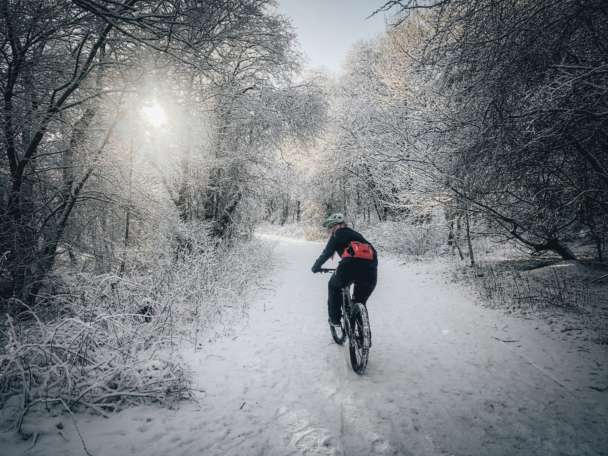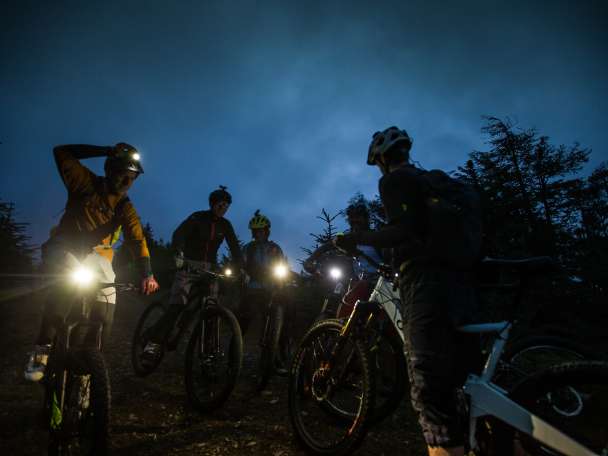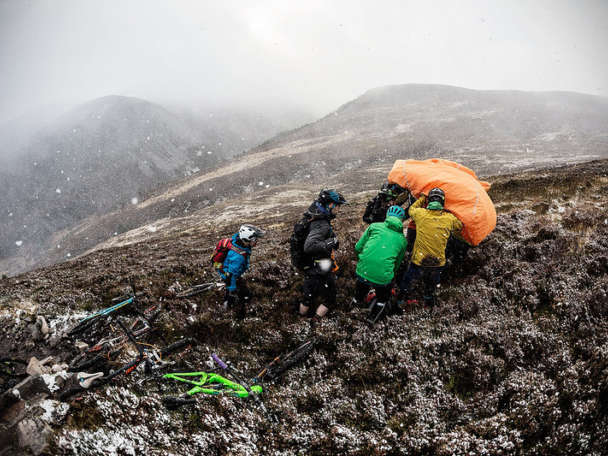Promoting important winter safety messages to all mountain bikers
#THINKWINTER is an annual campaign. We work alongside Mountaineering Scotland and their mountain safety partners to promote important winter safety messages to all mountain bikers, to help you have a safe and enjoyable winter, wherever you choose to ride.

With the right kit, preparation and advice, winter riding can be fun and rewarding.
But before you ride in winter, you need to be well prepared. If something goes wrong, with freezing temperatures and limited daylight hours, an incident, even fairly close to home, can become life threatening.
Here are some handy tips to think about before you embark on your winter riding adventure.

In Scotland, the weather can change very quickly and it is not unusual to encounter rain/sleet/snow/wind/sunshine all on the same day.
The weather, both the forecast for the day and the recent weather conditions, should affect your choice of route. Trails can become badly damaged if used after heavy spells of rain – so if you do choose to ride them you will have spoiled them for yourself, other riders and other trail users – think about switching to sustainable hardpack trail centre trails until the temperatures really dip and the trails firm up.
Check out mountain weather forecasts; temperatures can change dramatically as you head higher up into the hills and wind chill can easily drop the ‘feels like’ temperature down 10 degrees C or more.
Look at your route and try to work out where you could take an alternative or head back if the trails are too wet or obstructed, eg fallen trees, or the weather deteriorates.
And while out and about remember that bad weather can sneak in earlier than you expect!

Be ready for the worst that winter can throw at you and make sure that you pack:-
- a multi-tool
- extra food & water
- first aid kit
- foil blanket or 2 and know how to use it or better still a blizzard blanket
- emergency shelter
- pump
- spare inner tube
- Co2
- chain link
- map (& for more remote routes a compass)
- spare clothes including extra gloves
- a beanie
- neck tube and
- a down jacket/gilet that can be compressed
Hypothermia can and does kill. People can deteriorate very quickly in a winter environment. Managing a hypothermic casualty is challenging so check out the signs and symptoms so you can hope to recognise them in you and your group early on.
A mobile phone is essential. We would recommend bringing an extra battery pack as mobile phones are affected considerably by the cold.
Lights – we can easily be caught out by the onset of darkness – navigating your way from the top of the hill in darkness, is not fun.
We would also encourage you to pack an emergency shelter – vital to keep you and friends or injured party safe until emergency services get to you or that mechanical is sorted.
Remember, batteries can be seriously affected by the cold and touch screen phones may not work if your fingers are chilled so while always essential, consider what would happen if you can’t get the phone to work.
It’s not only batteries that can be temperamental in the cold; your bike can too. Water sneaking into moving parts can freeze and cause your bike to let you down.
If you are using a bladder pack for water, the water in the tube can freeze and that is annoying at best but dehydration even in the winter when you don’t think you are sweating can reduce your performance and cognitive skills.
This especially applies if you are riding alone. Let someone know your route and when you intend to return. This can just be a quick text to your ‘late back’ person. Simply giving the trails you intend to ride and the rough time it should take you.
If you do not contact them within half hour of that time, they should start calling you. If there is no reply after an agreed time – your ‘late back’ person should be contacting the emergency services.
Make sure they know how to do this and who to call! Do not go straight to café/pub and forget to let your ‘late back’ person you are ok. This is an easy habit to get into and could save your life.
Think about doing a first aid training course. First aid training isn’t just for professionals or mountain bike leaders – we all need to know the basics. If you are out riding with other and someone has an accident, you would want to know how best to help them. First Aid courses are happening all year – right across the country.
If an emergency occurs follow these simple steps from Mountaineering Scotland and Scottish Mountain Rescue:
- Stay calm. Take time to assess the situation and decide what to do.
- Check that you, the casualty and group aren't in immediate danger. If you are, seek to make the situation safe.
- If anyone is injured, remember ABC – airway, breathing and circulation (look for signs of life or blood loss)
- Treat any injuries (remember the first principle: ‘do no harm’)
- Insulate the casualty from the ground, add extra clothing. Place any unconscious casualties in the recovery position. Determine your exact position on the map and consider the options for either descending to safety, finding shelter, staying put or seeking help.
- Try to conserve mobile battery life by having all the details to hand before phoning for help. A list of the details needed is shown above.
- If there is no mobile coverage at your location, consider whether it might be worth moving to another location to phone from.
- If all other forms of communication fail, the internationally recognised emergency signals are six blasts on the whistle or six torch flashes repeated every minute.
Register with emergency SMS service
Register with the emergency SMS Service. Send the word ‘register’ to 999 and once registered you can use this service in case of poor phone signal. Your message should include which emergency service you need, e.g, mountain rescue, what the injury or incident is and your grid reference. Don’t assume the emergency services have received your text until you get a reply.
Here is an example of a good text (source MountainSafety.co.uk)

And finally - along with making sure your map reading skills are current, we would recommend downloading a location app such as OS Locate. It can help give you a location quickly and easily.
Further reading
#thinkwinter - Julie's Story

#thinkwinter 2022/2023

#thinkWINTER - Night Riding

You may also like
#thinkWINTER 2021/22

SUPPORT SCOTTISH MOUNTAIN BIKING!
Become a Supporter